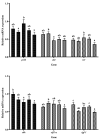Enzymatically Hydrolyzed Poultry By-Product Supplementation, Instead of Fishmeal, Alone Improves the Quality of Largemouth Bass (Micropterus salmoides) Back Muscle without Compromising Growth
- PMID: 37761194
- PMCID: PMC10529141
- DOI: 10.3390/foods12183485
Enzymatically Hydrolyzed Poultry By-Product Supplementation, Instead of Fishmeal, Alone Improves the Quality of Largemouth Bass (Micropterus salmoides) Back Muscle without Compromising Growth
Abstract
This study was designed to investigate the effects of enzymatically hydrolyzed poultry by-products (EHPB) on the growth and muscle quality of largemouth bass. Different concentrations of EHPB (0.00, 3.10, 6.20, 9.30, and 12.40%) were added to replace fishmeal (0.00 (control), 8.89 (EHPB1), 17.78 (EHPB2), 26.67 (EHPB3), and 35.56% (EHPB4)), respectively, in dietary supplementation. The results revealed that the growth performance and muscle amino acid and fatty acid remained unaltered in EHPB1 (p > 0.05). EHPB1 showed significant reduction in muscle hardness, gumminess, chewiness, and muscle fiber count and exhibited a significant increase in muscle fiber volume. The decrease in muscle hardness, gumminess, and chewiness means that the muscle can have a more tender texture. The expression of protein metabolism-related genes reached the highest levels in EHPB1 and EHPB2 (p < 0.05). The mRNA levels of s6k and igf-1 in EHPB2 and EHPB1 were significantly lower than those in the control group. Compared to the control group, the expression of muscle production-associated genes paxbp-1 was higher in EHPB1, and myod-1, myf-5, and syndecan-4 were higher in EHPB2. The mRNA levels of muscle atrophy-related genes, in EHPB4 and EHPB2, were significantly lower than those in the control group. Therefore, the EHPB1 group plays a role in promoting the expression of genes related to muscle formation. In summary, replacing 8.89% of fishmeal with EHPB in feed has no effect on growth and may improve back muscle quality in largemouth bass.
Keywords: enzymatically hydrolyzed poultry by-products; largemouth bass; muscle quality; protein source replacement.
Conflict of interest statement
The authors declare no conflict of interest.
Figures







Similar articles
-
Effects of replacing fishmeal with different proportions of mixed protein source in the diet of largemouth bass (Micropterus salmoides).Comp Biochem Physiol Part D Genomics Proteomics. 2024 Mar;49:101181. doi: 10.1016/j.cbd.2023.101181. Epub 2023 Dec 20. Comp Biochem Physiol Part D Genomics Proteomics. 2024. PMID: 38141372
-
Use of alternative protein sources for fishmeal replacement in the diet of largemouth bass (Micropterus salmoides). Part II: effects of supplementation with methionine or taurine on growth, feed utilization, and health.Amino Acids. 2021 Jan;53(1):49-62. doi: 10.1007/s00726-020-02922-4. Epub 2021 Jan 4. Amino Acids. 2021. PMID: 33398521
-
Use of alternative protein sources for fishmeal replacement in the diet of largemouth bass (Micropterus salmoides). Part I: effects of poultry by-product meal and soybean meal on growth, feed utilization, and health.Amino Acids. 2021 Jan;53(1):33-47. doi: 10.1007/s00726-020-02920-6. Epub 2020 Nov 24. Amino Acids. 2021. PMID: 33236255
-
Retrospect of fishmeal substitution in largemouth bass (Micropterus salmoides): a review.Fish Physiol Biochem. 2025 Feb;51(1):21. doi: 10.1007/s10695-024-01429-z. Epub 2024 Dec 7. Fish Physiol Biochem. 2025. PMID: 39643859 Review.
-
Effects of bioprocessed soybean meal and nucleotide supplementation on growth, physiology and histomorphology in largemouth bass, Micropterus salmoides, juveniles.Comp Biochem Physiol A Mol Integr Physiol. 2021 Oct;260:111038. doi: 10.1016/j.cbpa.2021.111038. Epub 2021 Jul 13. Comp Biochem Physiol A Mol Integr Physiol. 2021. PMID: 34271205 Review.
Cited by
-
Dietary γ-Aminobutyric Acid Promotes Growth and Immune System Performance and Improves Erythropoiesis and Angiogenesis in Gibel Carp (Carassius auratus gibelio).Animals (Basel). 2025 Jan 7;15(2):125. doi: 10.3390/ani15020125. Animals (Basel). 2025. PMID: 39858125 Free PMC article.
-
Effects of Dietary Ferroporphyrin Supplementation on Growth Performance, Antioxidant Capacity, Immune Response, and Oxygen-Carrying Capacity in Gibel Carp (Carassius auratus gibelio).Animals (Basel). 2024 Oct 28;14(21):3104. doi: 10.3390/ani14213104. Animals (Basel). 2024. PMID: 39518827 Free PMC article.
-
Impact of Rearing Duration on Nutritional Composition, Flavor Characteristics, and Physical Properties of Asian Swamp Eel (Monopterus albus).Foods. 2025 May 9;14(10):1685. doi: 10.3390/foods14101685. Foods. 2025. PMID: 40428465 Free PMC article.
References
-
- Merino G., Barange M., Blanchard J.L., Harle J., Holmes R., Allen I., Allison E.H., Badjeck M.C., Dulvy N.K., Holt J., et al. Can Marine Fisheries and Aquaculture Meet Fish Demand from a Growing Human Population in a Changing Climate? Glob. Environ. Chang. 2012;22:795–806. doi: 10.1016/j.gloenvcha.2012.03.003. - DOI
-
- Tacon A.G.J., Metian M. Feed Matters: Satisfying the Feed Demand of Aquaculture. Rev. Fish. Sci. Aquac. 2015;23:1–10. doi: 10.1080/23308249.2014.987209. - DOI
-
- Cottrell R.S., Blanchard J.L., Halpern B.S., Metian M., Froehlich H.E. Global Adoption of Novel Aquaculture Feeds Could Substantially Reduce Forage Fish Demand by 2030. Nat. Food. 2020;1:301–308. doi: 10.1038/s43016-020-0078-x. - DOI
Grants and funding
LinkOut - more resources
Full Text Sources
Miscellaneous

